A Three-Step Method for Determining Unhealthy Time Period of GPS Satellite Orbit in Broadcast Ephemeris and Its Preliminary Applications for Precise Orbit Determination
Abstract
:1. Introduction
2. Materials and Methods
2.1. The First Step: Calculating the Datum Clock Offset
- The median of is calculated as:where , is the number of satellites observed at the datum station, and the symbol indicates the median calculated for this sequence .
- The initial residuals are calculated as:
- The robust variance factor is calculated as [36]:
- The robust weights are calculated as [36]:where we selected in this work.
- Calculate the datum clock offset:
2.2. The Second Step: Removing Receiver Clock Offsets of Other Reference Stations
2.3. The Third Step: Detecting Unhealthy GPS Satellite Orbit Arc in Broadcast Ephemeris
2.3.1. Thread One
- The median of is calculated as:
- The initial residuals ( and ) are calculated as:
- The initial robust variance factor is calculated as:
- The robust factors and their equivalent weights are calculated as:
- The robust variance factor is calculated as:
- The detection conditions are provided as follows:
2.3.2. Thread Two
- Calculate according to Equation (18).
- Calculate the three-dimensional error .
- If the consecutive number of calculated epochs in which the satellite orbit of the broadcast ephemeris maintained health status exceeds 10, a sequence can be obtained from Equation (28). The offset threshold can be calculated from Equation (29).
- The detection conditions are provided as follows:
2.3.3. Comprehensive Evaluation
- If both Equations (26a) and (30a) are satisfied at the same time within (in this draft, ) consecutive epochs, it can be assumed that there is an orbit leap in satellite of broadcast ephemeris at time , and a separate sub-arc will be set up at the begin-time of the unhealthy time period when the broadcast ephemeris is used to create the a priori orbit during POD.
- If either one of the Equations (26a) or (30a) is satisfied, it can be concluded that there is an orbital anomaly in satellite of broadcast ephemeris at time , and the observation data will be deleted at time when the broadcast ephemeris is used to create a priori orbit during POD.
- In all other cases, satellite is usable at time . When the satellite orbit of the broadcast ephemeris stays leaped or has an anomalous status before the time , if this condition is met in this time , then the unhealthy time period ends in this time , and this time is the unhealthy end-time.
3. Preliminary Analysis Results
4. Discussion
5. Conclusions
- It can provide a feasible approach to detect unhealthy time periods of satellite orbits of broadcast ephemerides in real-time.
- It allows unhealthy time period detection for a satellite orbit of a broadcast ephemeris all day long by comprehensive evaluation.
- Compared to the unhealthy orbit arc information of NAVCEN and the broadcast ephemeris, the proposed method can increase observation utilization of an unhealthy satellite of about several hours.
- Compared to the traditional method, the proposed method helps to improve the reliability of unhealthy orbit arc information. Firstly, the unhealthy start-time of the satellite orbit of the broadcast ephemeris, using the three-step method, is closer to that provided by CODE. Secondly, the traditional method can misjudge the orbit status of a satellite of the broadcast ephemeris. In contrast, the proposed three-step method can distinguish the orbit status of a satellite. Besides, the traditional method is susceptible to abnormal values when eliminating the clock offset, and this result is also consistent with the theory. Last but not least, in the POD application, using the unhealthy time period detected by the three-step method shows an improvement in orbit accuracy.
Author Contributions
Funding
Acknowledgments
Conflicts of Interest
References
- Lichten, S.M.; Border, J.S. Strategies for high-precision Global Positioning System orbit determination. J. Geophys. Res. Solid Earth 1987, 92, 12751–12762. [Google Scholar] [CrossRef]
- Montenbruck, O.; Schmid, R.; Mercier, F.; Steigenberger, P.; Noll, C.; Fatkulin, R.; Kogure, S.; Ganeshan, A.S. GNSS satellite geometry and attitude models. Adv. Space Res. 2015, 56, 1015–1029. [Google Scholar] [CrossRef]
- Montenbruck, O.; Steigenberger, P.; Prange, L.; Deng, Z.G.; Zhao, Q.L.; Perosanz, F.; Romero, I.; Noll, C.; Sturze, A.; Weber, G.; et al. The Multi-GNSS Experiment (MGEX) of the International GNSS Service (IGS)—Achievements, prospects and challenges. Adv. Space Res. 2017, 59, 1671–1697. [Google Scholar] [CrossRef]
- Guo, J.; Chen, G.; Zhao, Q.; Liu, J.; Liu, X. Comparison of solar radiation pressure models for BDS IGSO and MEO satellites with emphasis on improving orbit quality. GPS Solut. 2017, 21, 511–522. [Google Scholar] [CrossRef]
- Zhao, Q.; Chen, G.; Guo, J.; Liu, J.; Liu, X. An a priori solar radiation pressure model for the QZSS Michibiki satellite. J. Geod. 2018, 92, 109–121. [Google Scholar] [CrossRef]
- Li, X.; Chen, X.; Ge, M.; Schuh, H. Improving multi-GNSS ultra-rapid orbit determination for real-time precise point positioning. J. Geod. 2018. [Google Scholar] [CrossRef]
- Kang, Z.; Tapley, B.; Bettadpur, S.; Ries, J.; Nagel, P.; Pastor, R. Precise orbit determination for the GRACE mission using only GPS data. J. Geod. 2006, 80, 322–331. [Google Scholar] [CrossRef]
- Kusche, J. Approximate decorrelation and non-isotropic smoothing of time-variable GRACE-type gravity field models. J. Geod. 2007, 81, 733–749. [Google Scholar] [CrossRef]
- Jäggi, A.; Hugentobler, U.; Bock, H.; Beutler, G. Precise orbit determination for GRACE using undifferenced or doubly differenced GPS data. Adv. Space Res. 2007, 39, 1612–1619. [Google Scholar] [CrossRef]
- Li, X.; Ge, M.; Dai, X.; Ren, X.; Fritsche, M.; Wickert, J.; Schuh, H. Accuracy and reliability of multi-GNSS real-time precise positioning: GPS, GLONASS, BeiDou, and Galileo. J. Geod. 2015, 89, 607–635. [Google Scholar] [CrossRef]
- Guo, F.; Li, X.; Zhang, X.; Wang, J. Assessment of precise orbit and clock products for Galileo, BeiDou, and QZSS from IGS Multi-GNSS Experiment (MGEX). GPS Solut. 2017, 21, 279–290. [Google Scholar] [CrossRef]
- Kazmierski, K.; Sosnica, K.; Hadas, T. Quality assessment of multi-GNSS orbits and clocks for real-time precise point positioning. GPS Solut. 2017, 22, 12. [Google Scholar] [CrossRef]
- Dach, R.; Lutz, S.; Walser, P.; Fridez, P. Prepare the Orbit Improvement. Bernese GNSS Software Version 5.2; Astronomical Institute, University of Bern: Bern, Switzerland, 2015; p. 379. [Google Scholar]
- He, L.; Ge, M.; Wang, J.; Wickert, J.; Schuh, H. Experimental study on the precise orbit determination of the BeiDou navigation satellite system. Sensors 2013, 13, 2911–2928. [Google Scholar] [CrossRef]
- Ye, F.; Yuan, Y.; Ou, J. Initial orbit determination of BDS-3 satellites based on new code signals. Geod. Geodyn. 2018, 9, 342–346. [Google Scholar] [CrossRef]
- Heng, L.; Gao, G.X.; Walter, T.; Enge, P. GPS ephemeris error screening and results for 2006–2009. In Proceedings of the 2010 International Technical Meeting of the Institute of Navigation (ION ITM 2010), San Diego, CA, USA, 25–27 January 2010; pp. 1014–1022. [Google Scholar]
- Wang, H.; Jiang, H.; Ou, J.; Sun, B.; Zhong, S.; Song, M.; Guo, A. Anomaly analysis of 18 years of newly merged GPS ephemeris from four IGS data centers. GPS Solut. 2018, 22, 124. [Google Scholar] [CrossRef]
- Steigenberger, P.; Hugentobler, U.; Hauschild, A.; Montenbruck, O. Orbit and clock analysis of Compass GEO and IGSO satellites. J. Geod. 2013, 87, 515–525. [Google Scholar] [CrossRef]
- Byun, S. Satellite orbit determination using triple-differenced GPS carrier phase in pure kinematic mode. J. Geod. 2003, 76, 569–585. [Google Scholar] [CrossRef]
- Huang, Y.; Hu, X.; Zhang, X.; Jiang, D.; Guo, R.; Wang, H.; Shi, S. Improvement of orbit determination for geostationary satellites with VLBI tracking. Chin. Sci. Bull. 2011, 56, 2765. [Google Scholar] [CrossRef]
- Cao, F.; Yang, X.; Li, Z.; Sun, B.; Kong, Y.; Chen, L.; Feng, C. Orbit determination and prediction of GEO satellite of BeiDou during repositioning maneuver. Adv. Space Res. 2014, 54, 1828–1837. [Google Scholar] [CrossRef]
- Davis, T.; Melanson, D. XSS-10 microsatellite flight demonstration program results. Spacecr. Platf. Infrastruct. 2004, 5419, 16–26. [Google Scholar]
- Ye, F.; Yuan, Y.; Tan, B.; Ou, J. A robust method to detect beidou navigation satellite system orbit maneuvering/anomalies and its applications to precise orbit determination. Sensors 2017, 17, 1129. [Google Scholar] [CrossRef] [PubMed]
- Liu, Z.; Qu, L.; Zhao, Q. Real -time Anomaly Detection of BDS Broadcast Ephemeris. In Proceedings of the Fifth China Satellite Navigation Conference (CSNC), Nanjing, China, 21–23 May 2014; pp. 107–112. [Google Scholar]
- Huang, G.; Qin, Z.; Zhang, Q.; Wang, L.; Yan, X.; Fan, L.; Wang, X. A real-time robust method to detect BeiDou GEO/IGSO orbital maneuvers. Sensors 2017, 17, 2761. [Google Scholar] [CrossRef] [PubMed]
- Huang, G.; Qin, Z.; Zhang, Q.; Wang, L.; Yan, X.; Wang, X. An optimized method to detect BDS satellites’ orbit maneuvering and anomalies in real-time. Sensors 2018, 18, 726. [Google Scholar] [CrossRef] [PubMed]
- Dow, J.M.; Neilan, R.E.; Rizos, C. The international GNSS service in a changing landscape of global navigation satellite systems. J. Geod. 2009, 83, 191–198. [Google Scholar] [CrossRef]
- Hugentobler, U.; Meindl, M.; Beutler, G.; Bock, H.; Dach, R.; Jäggi, A.; Urschl, C.; Mervart, L.; Rothacher, M.; Schaer, S. CODE IGS Analysis Center Technical Report 2003/2004; Gowey, K., Neilan, R., Moore, A., Eds.; IGS 2004 Technical Reports; IGS Central Bureau: Bern, Switzerland, 2006. [Google Scholar]
- Dach, R.; Lutz, S.; Walser, P.; Fridez, P. The Osculating Orbital Elements/Checking GNSS Broadcast Messages. In Bernese GNSS Software Version 5.2; Astronomical Institute, University of Bern: Bern, Switzerland, 2015; pp. 32–46, 107–125. [Google Scholar]
- Tsai, Y.-J. Wide area Differential Operation of the Global Positioning System: Ephemeris and Clock Algorithms. Ph.D. Dissertation, Stanford University, Stanford, CA, USA, 1999. [Google Scholar]
- Kee, C.; Parkinson, B.W.; Axelrad, P. Wide area differential GPS. Navigation 1991, 38, 123–145. [Google Scholar] [CrossRef]
- Hwang, P.Y.; McGraw, G.A.; Bader, J.R. Enhanced differential GPS carrier-smoothed code processing using dual-frequency measurements. Navigation 1999, 46, 127–137. [Google Scholar] [CrossRef]
- Rothacher, M.; Springer, T.; Schaer, S.; Beutler, G. Processing strategies for regional GPS networks. In Advances in Positioning and Reference Frames; Springer: Berlin/Heidelberg, Germany, 1998; pp. 93–100. [Google Scholar]
- Yan, W.; Ou, J.; Yuan, Y.; Salazar, D. Research on network augmented real-time precise point positioning algorithm with broadcast ephemeris. Geomat. Inf. Sci. Wuhan Univ. 2012, 37, 1190–1193. [Google Scholar] [CrossRef]
- Montenbruck, O.; Steigenberger, P.; Hauschild, A. Broadcast versus precise ephemerides: A multi-GNSS perspective. GPS Solut. 2015, 19, 321–333. [Google Scholar] [CrossRef]
- Yang, Y. Robust estimation of geodetic datum transformation. J. Geod. 1999, 73, 268–274. [Google Scholar] [CrossRef]
- Boehm, J.; Heinkelmann, R.; Schuh, H. Short Note: A global model of pressure and temperature for geodetic applications. J. Geod. 2007, 81, 679–683. [Google Scholar] [CrossRef]
- Boehm, J.; Niell, A.; Tregoning, P.; Schuh, H. Global Mapping Function (GMF): A new empirical mapping function based on numerical weather model data. Geophys. Res. Lett. 2006, 33, 4. [Google Scholar] [CrossRef]
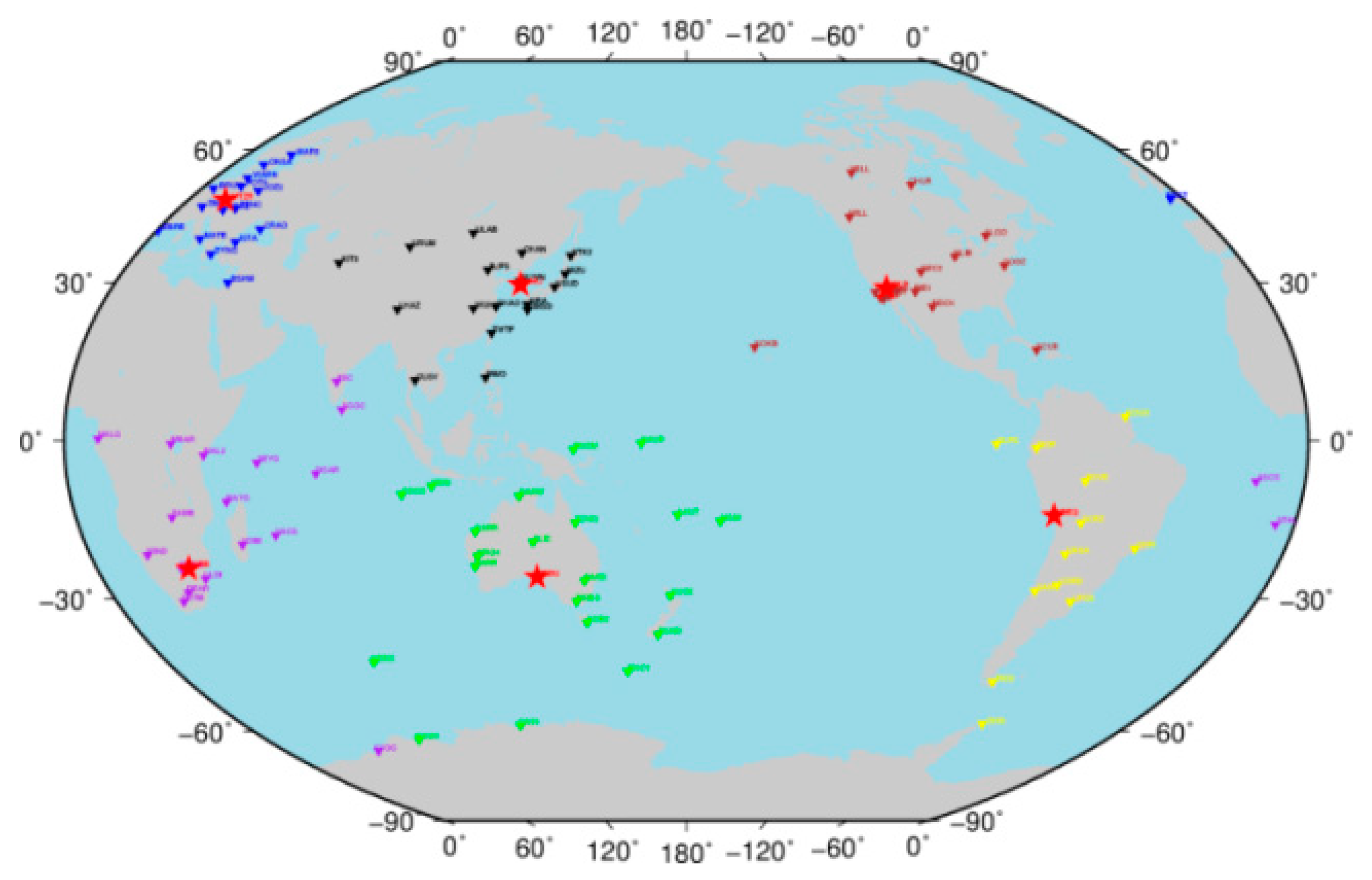
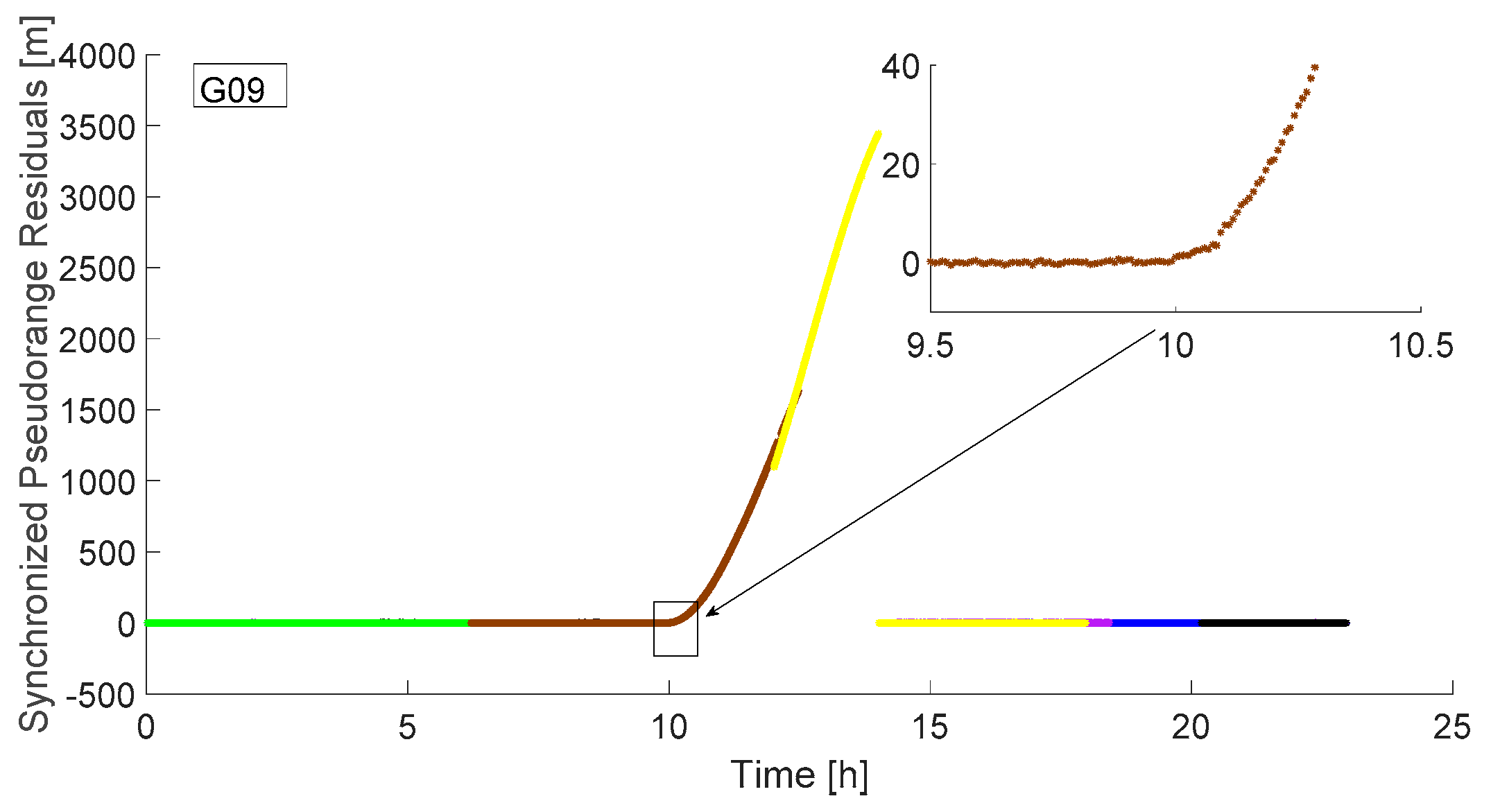
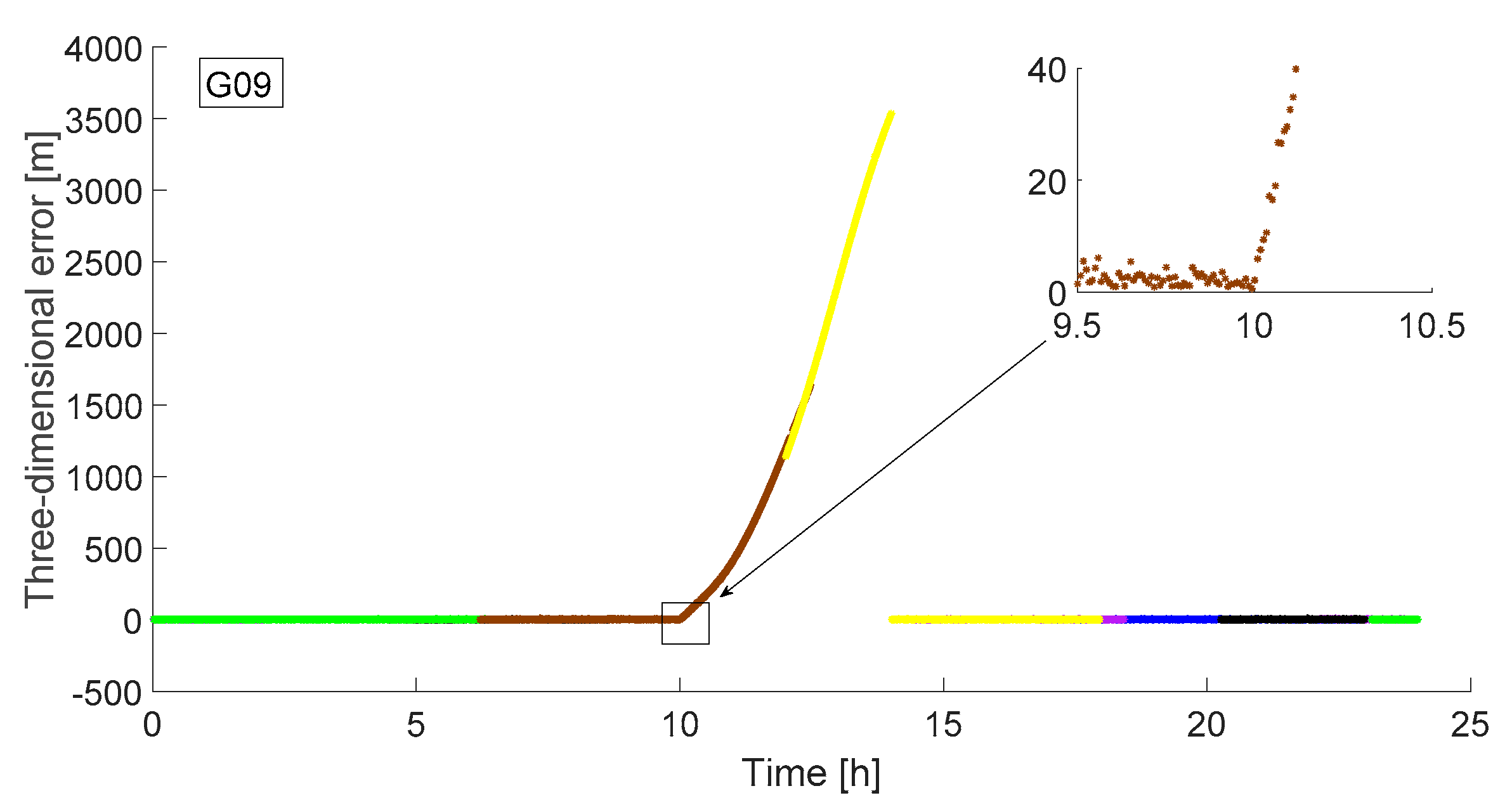
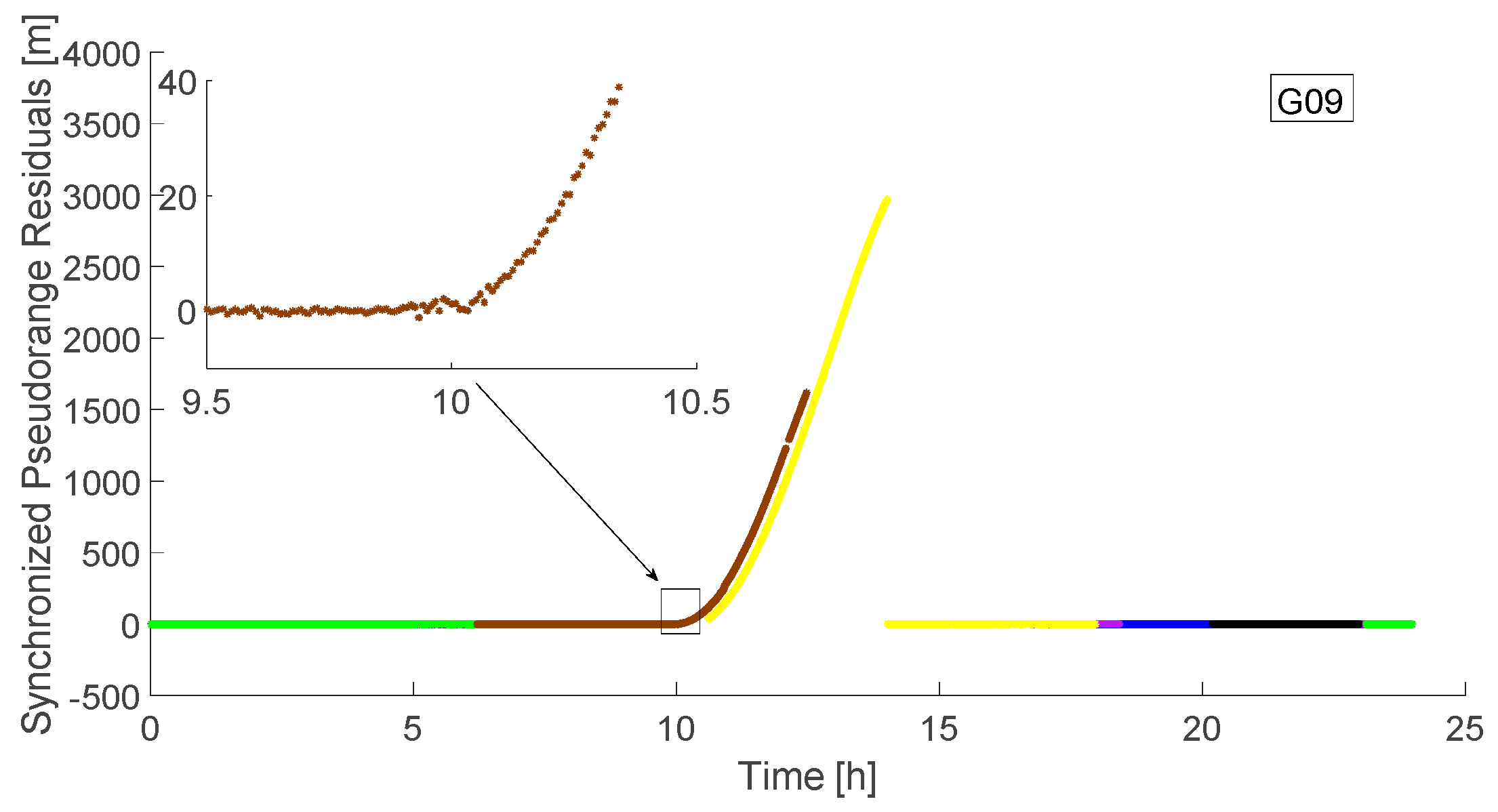
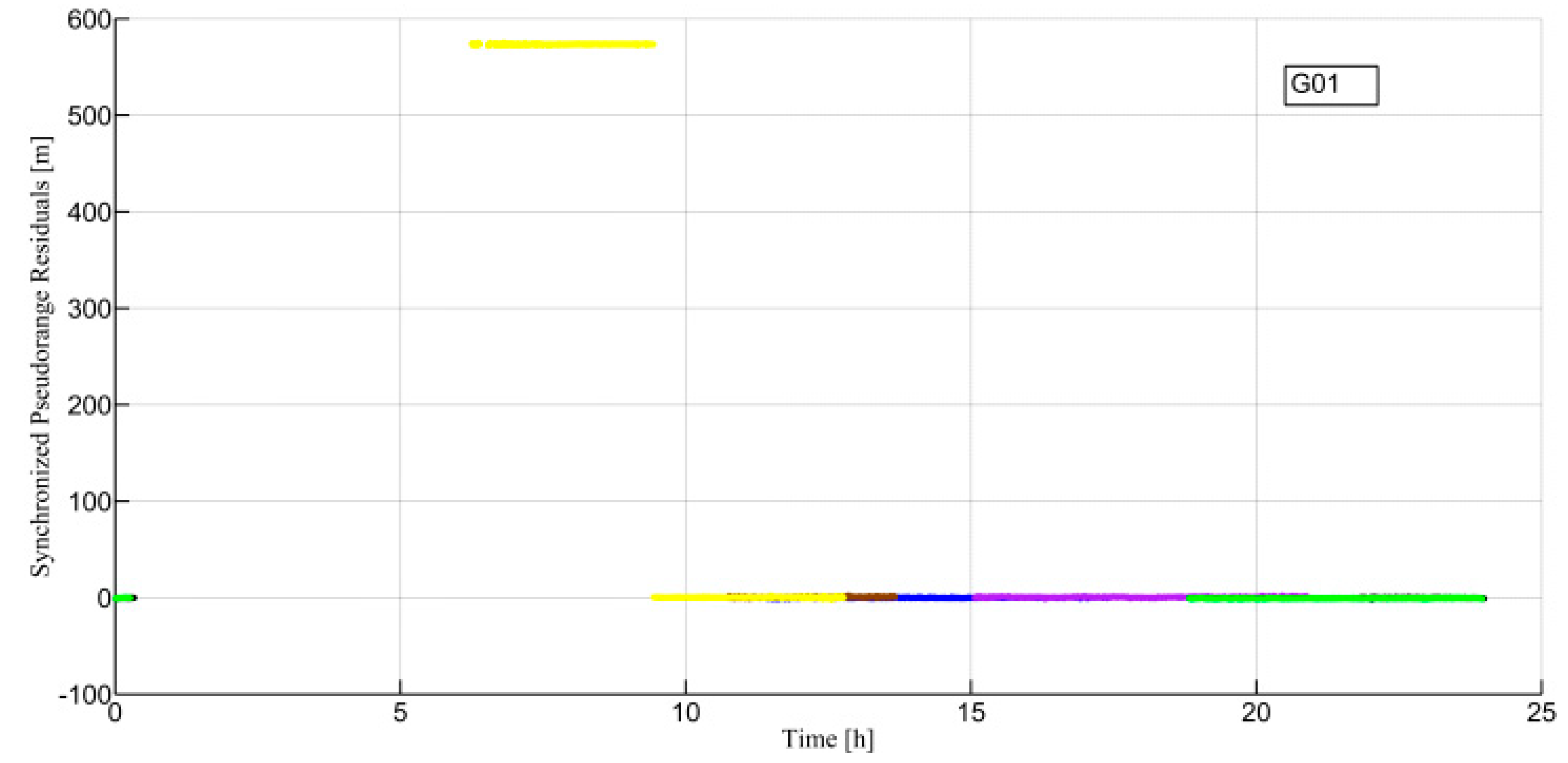
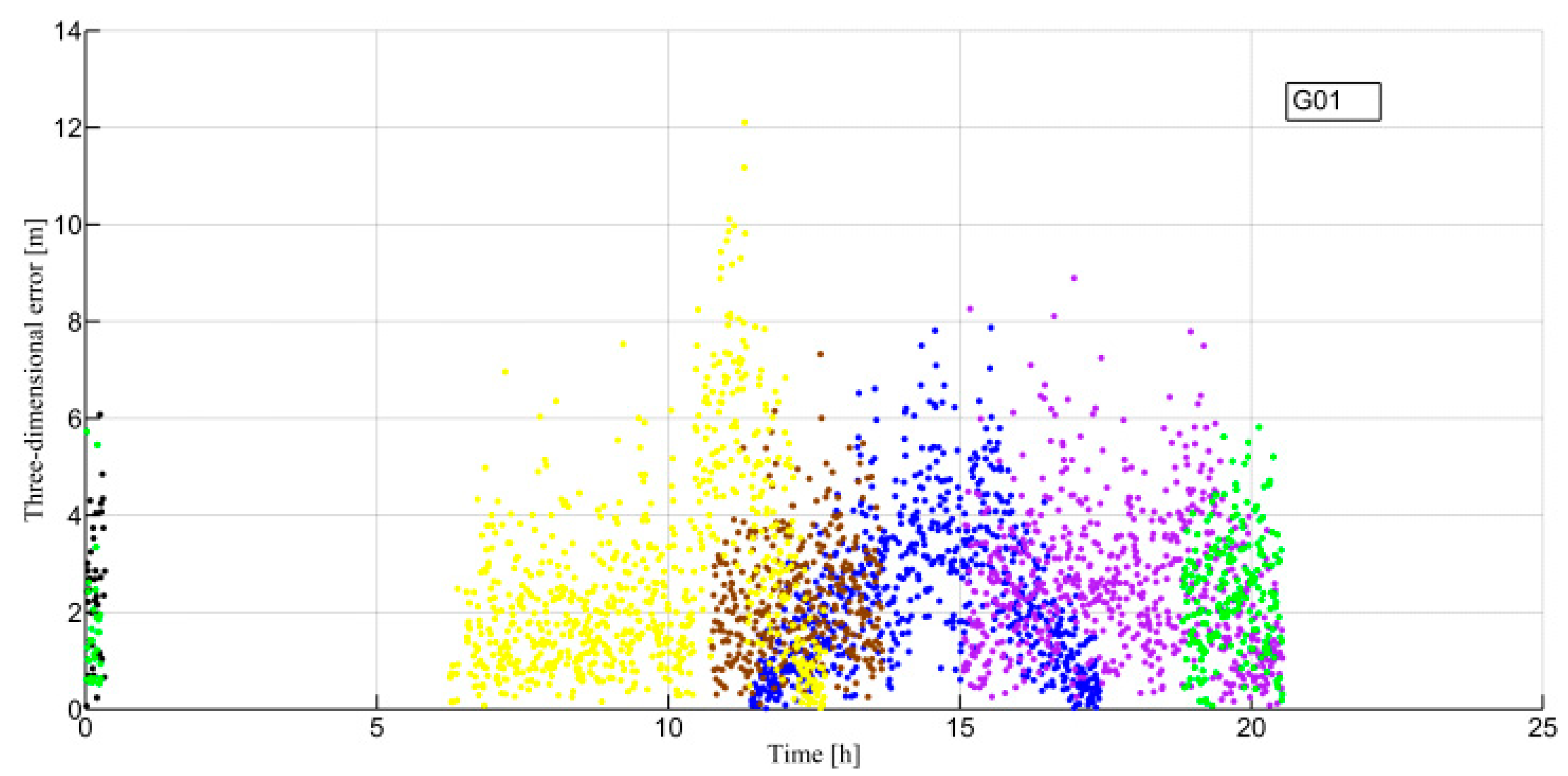
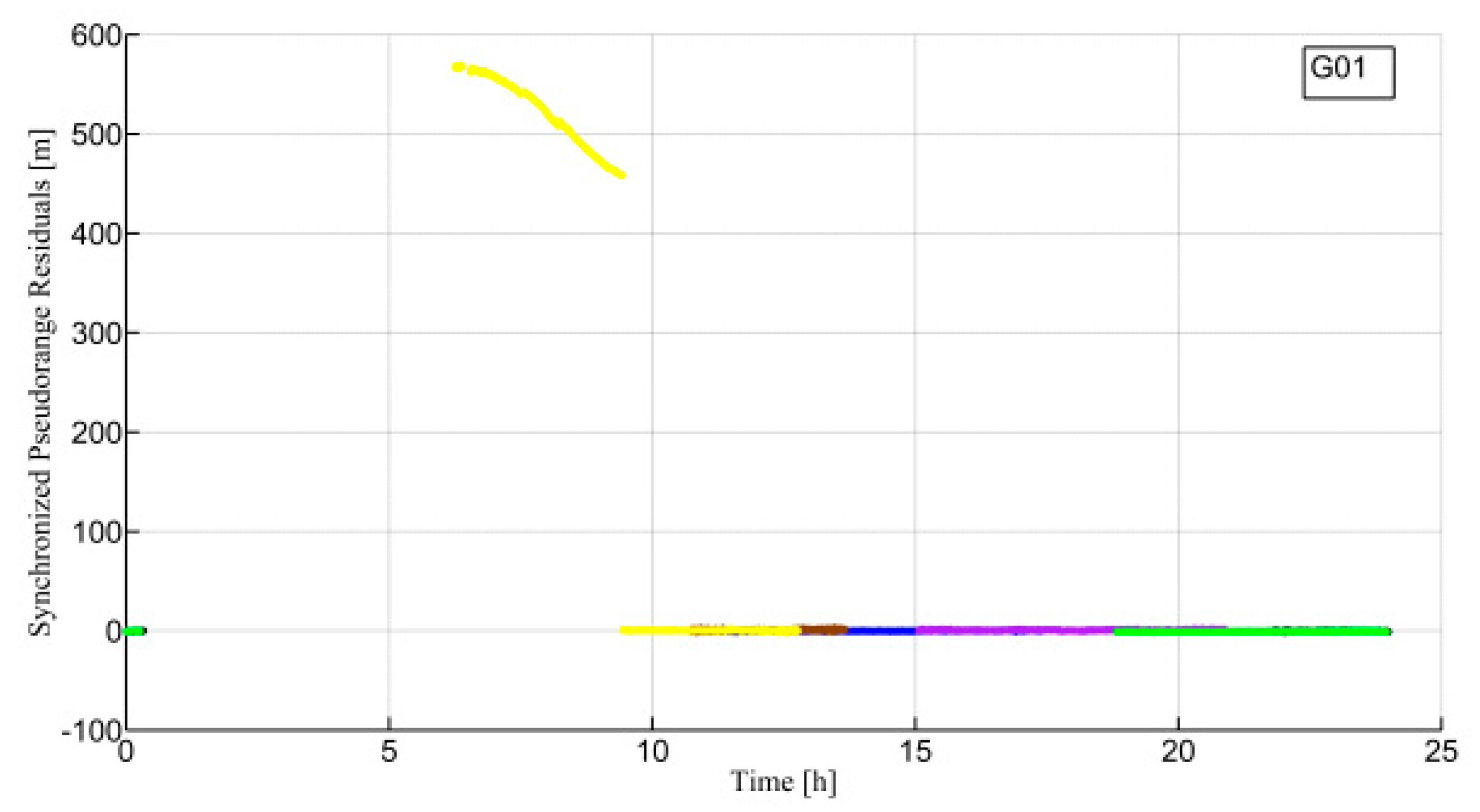
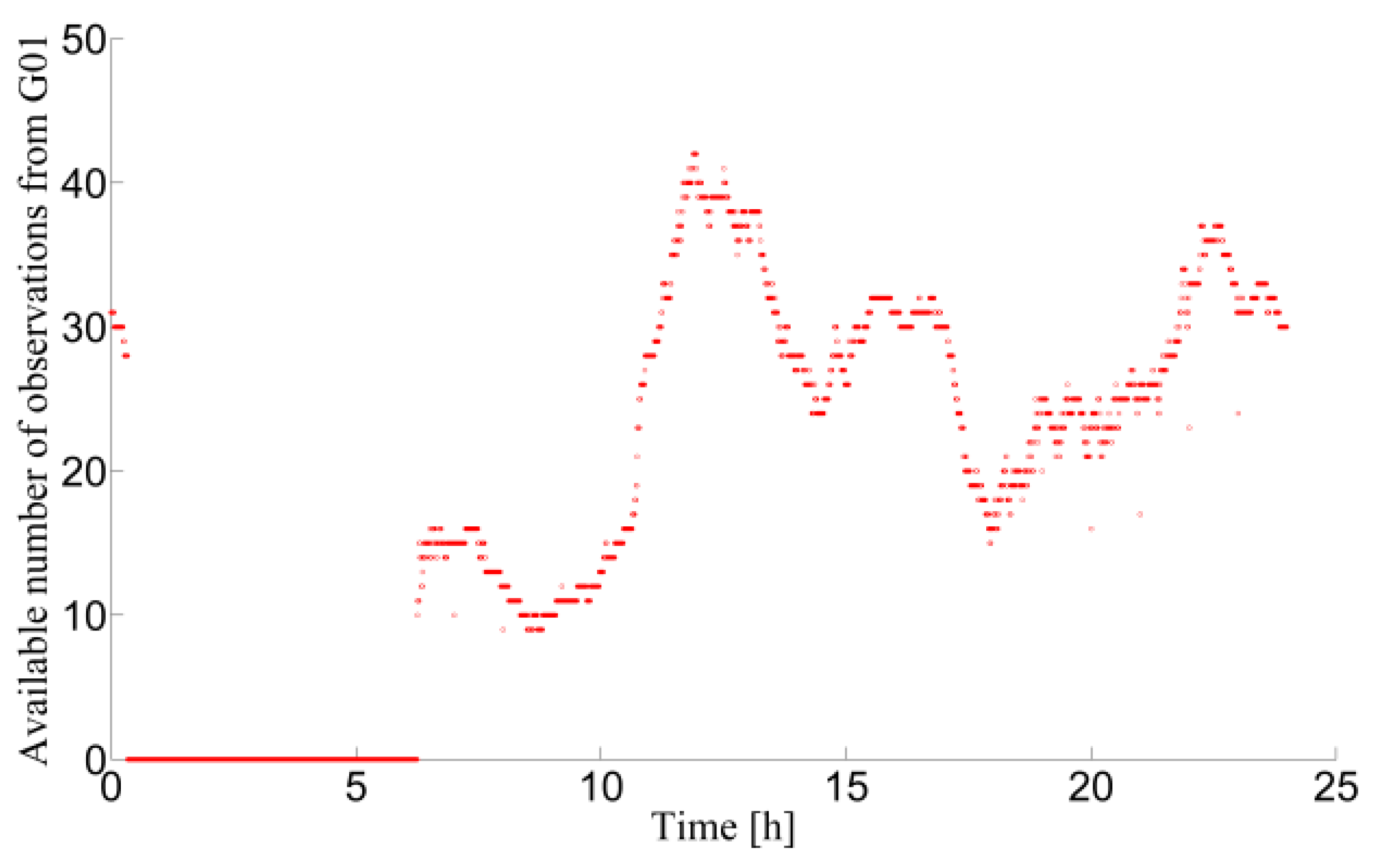
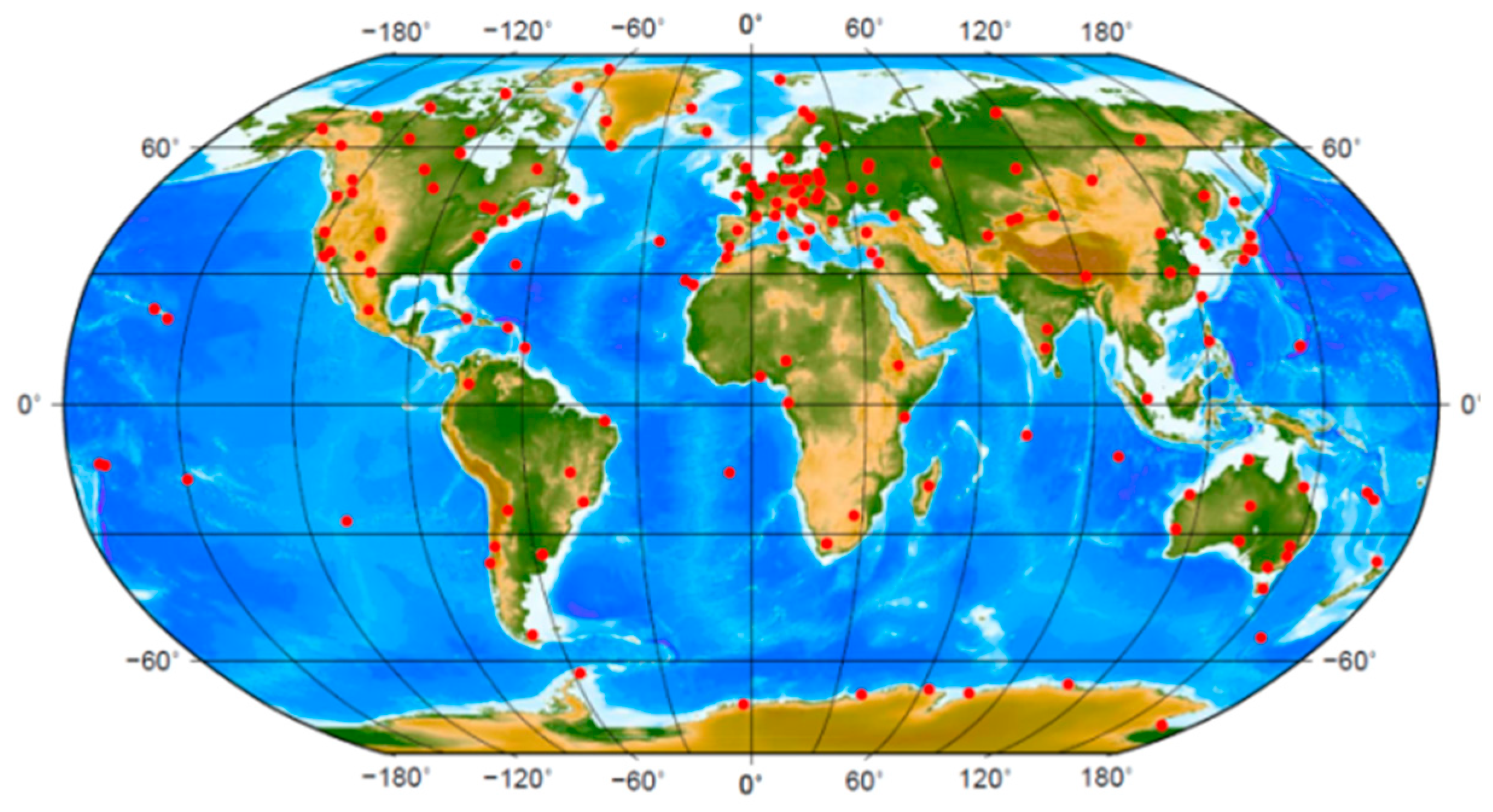
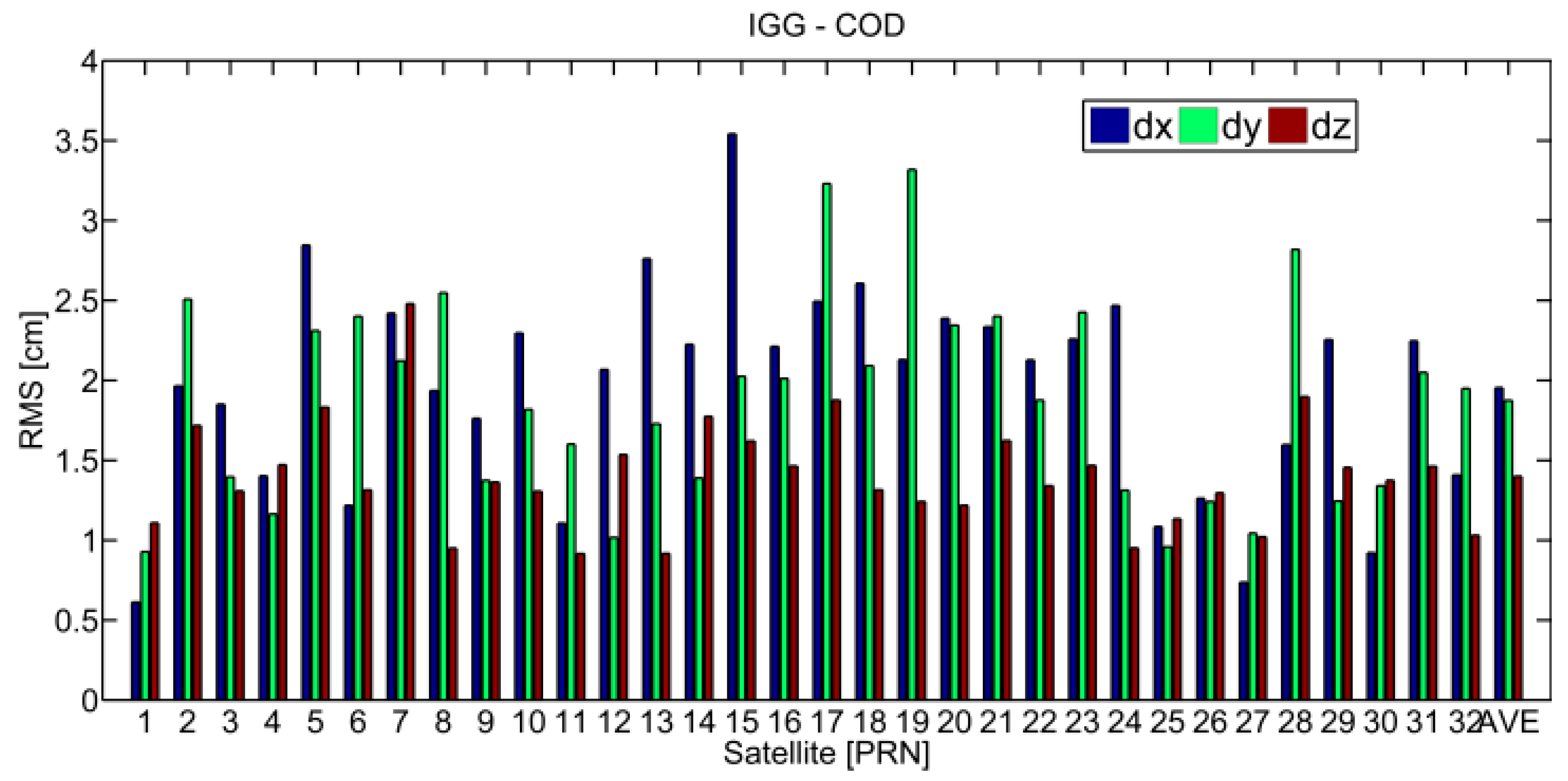
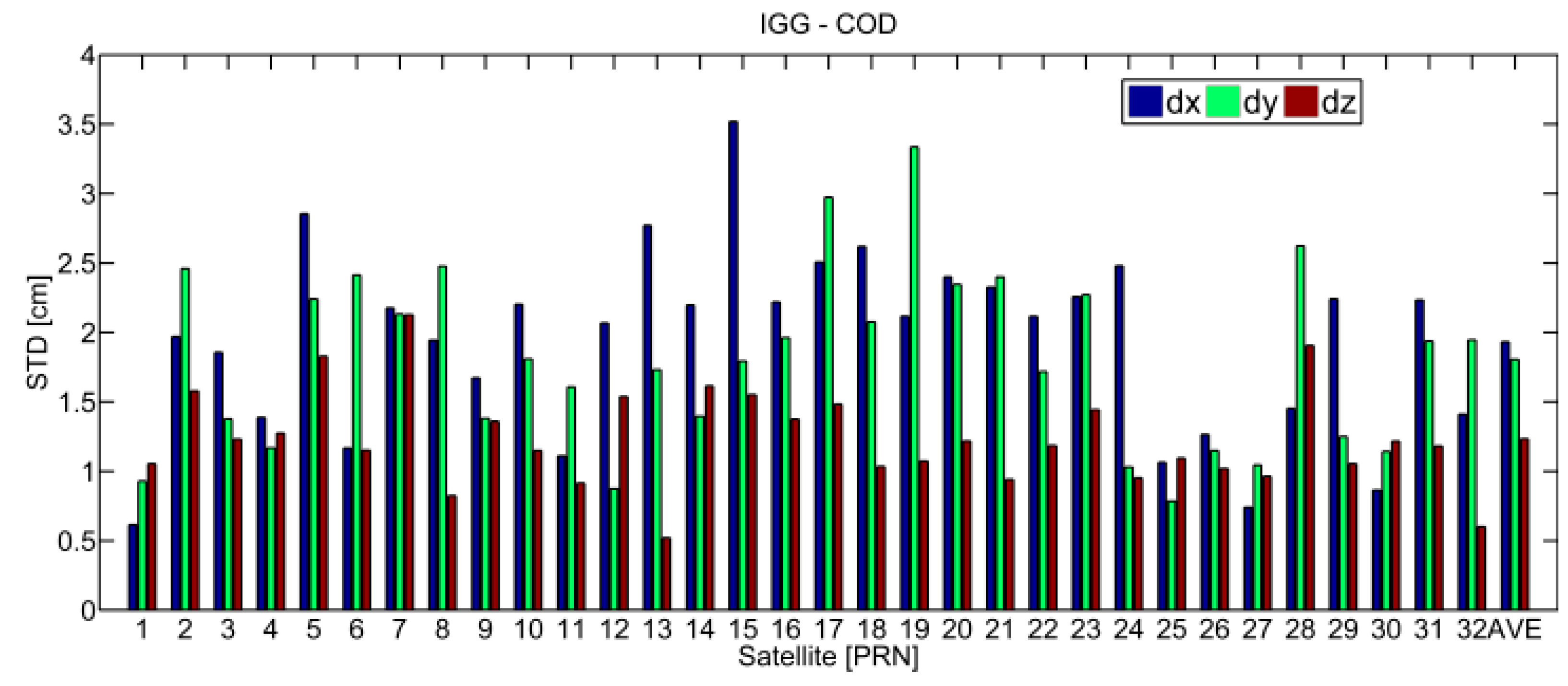
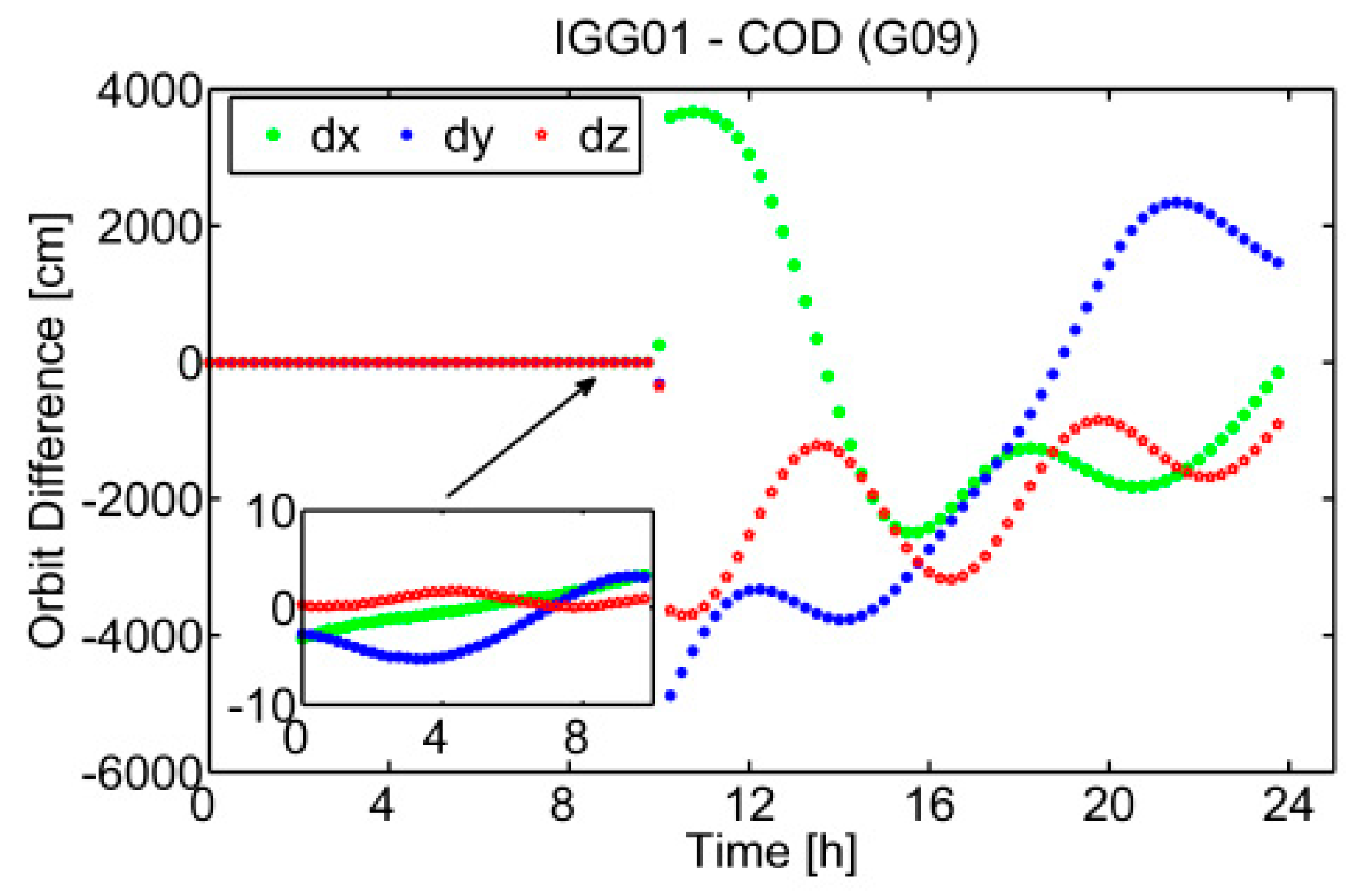
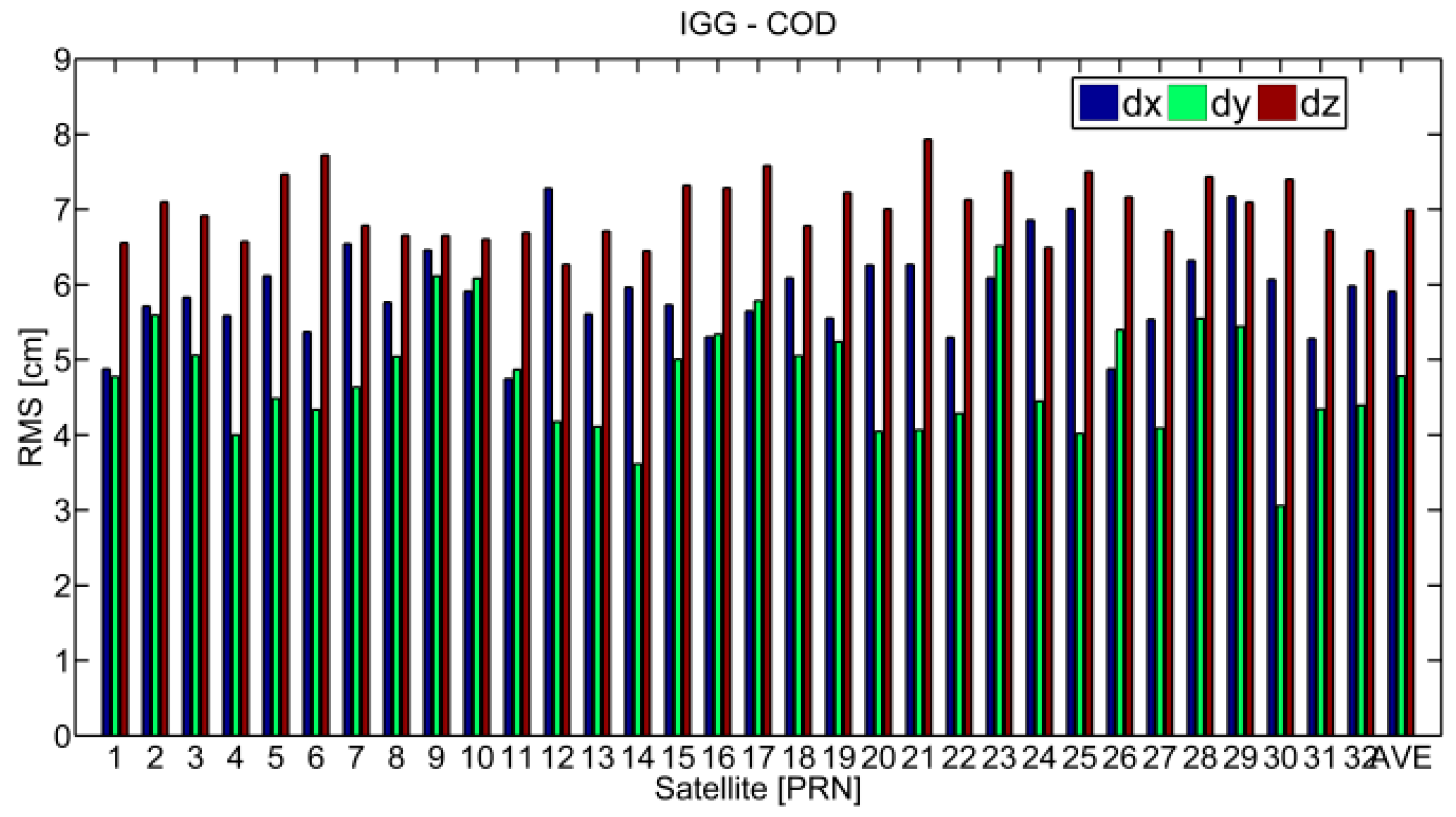
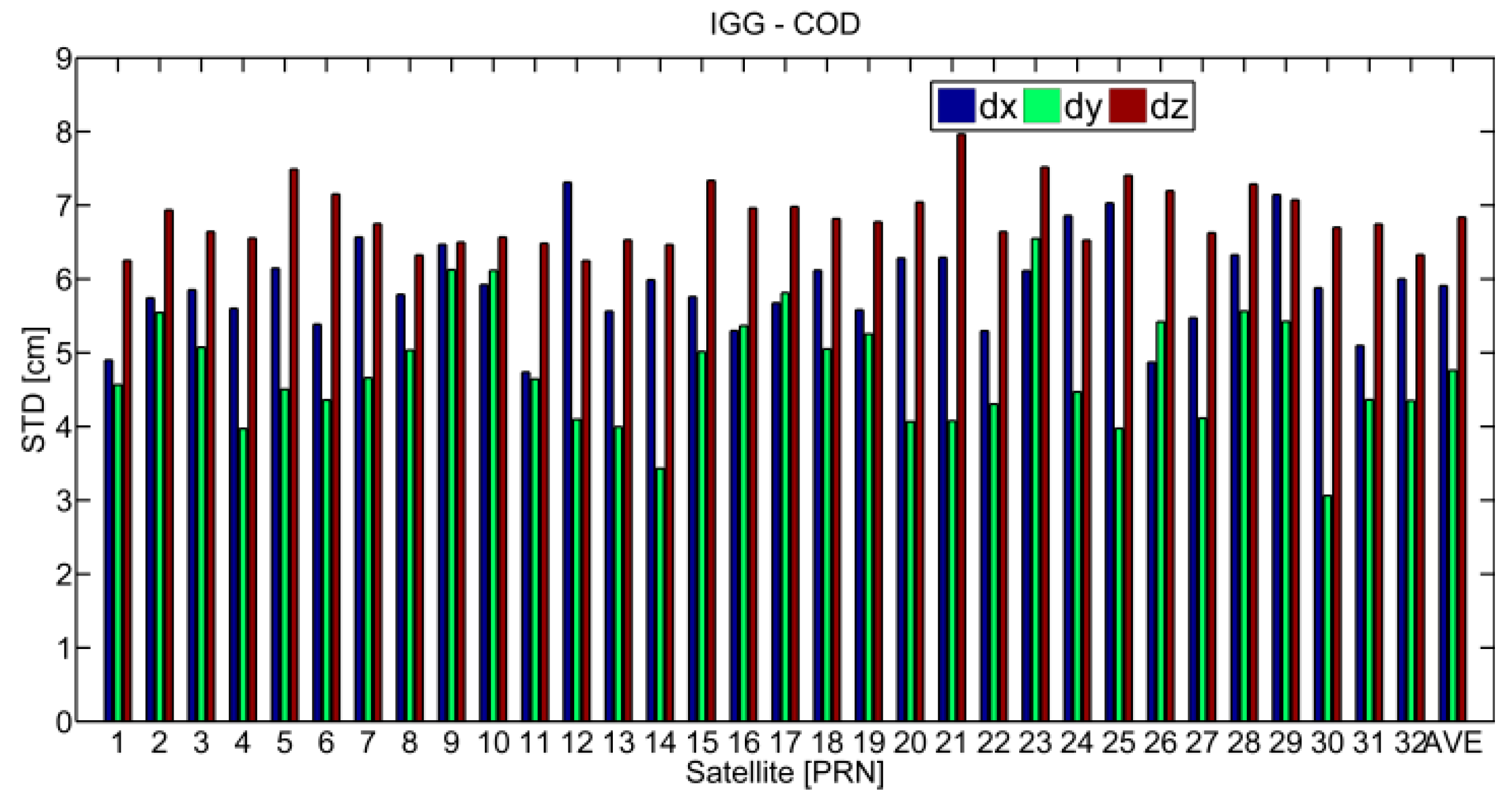
| Regional Network | Number of Stations | Name of the Datum Station |
|---|---|---|
| 1 | 19 | GOL2 |
| 2 | 13 | AREQ |
| 3 | 17 | WTZR |
| 4 | 22 | CEDU |
| 5 | 18 | DAEJ |
| 6 | 22 | HARB |
| PRN(G09): August 25, 2017 | Unusable Start Time (UTC) | Unusable Stop Time (UTC) | Unhealthy Time Period (UTC) | |
|---|---|---|---|---|
| Three-step Method | Thread one | 09:59:42 | 14:00:42 | 09:59:42–14:00:42 (there is an orbit leap ) |
| Thread two | 09:59:42 | 14:00:42 | ||
| Comprehensive evaluation | 09:59:42 | 14:00:42 | ||
| CODE’s satellite crux files | 09:59:28–(maneuver) | |||
| Information from NAVCEN | 08:47:00 | 13:58:00 | 08:47:00–13:58:00 | |
| Health Flag from the Broadcast Ephemeris | 09:59:26 | 15:57:02 | 09:59:26–15:57:02 | |
| Traditional Method | 10:05:12 | 14:00:42 | 10:05:12–14:00:42 (there is an orbit leap ) | |
| PRN(G01): September 14, 2017 | Unusable Start Time (UTC) | Unusable Stop Time (UTC) | Unhealthy Time Period (UTC) | |
|---|---|---|---|---|
| Three-step Method | Thread one | 06:14:42 | 09:26:12 | 06:14:42–09:26:12 |
| Thread two | ||||
| Comprehensive evaluation | 06:14:42 | 09:26:12 | ||
| CODE’s satellite crux files | ||||
| Information from NAVCEN | 00:21:00 | 09:26:00 | 00:21:00–09:26:00 | |
| Health Flag from the Broadcast Ephemeris * | 07:59:10 | 09:58:38 | 07:59:10–09:58:38 | |
| Traditional Method | 06:14:42 | 09:26:12 | 06:14:42–09:26:12 (there is an orbit leap ) | |
| Items | Description |
|---|---|
| Number of stations | ~150 |
| Processing mode | Middle day of 3-day arc |
| Processing scheme | Double-difference network processing (observable: phase double differences, ionosphere-free linear combination) |
| Elevation mask | 5°; elevation-dependent weighting |
| Observation sampling period | 30 s |
| Satellite/Receiver clock error | Double-difference |
| Ionosphere | Ionosphere-free linear combination |
| Tropospheric delay | GMF mapping function; ZHD: GPT model, ZWD is estimated every 2 h based on the piece-wise function [37,38] |
| A priori orbits | Broadcast ephemeris |
| A priori coordinates | Previous 3-day solution |
| Earth gravity | EGM2008 12 × 12 |
| Solar radiation | ECOM 5-parameter model |
| Solid earth Tide and pole tide | IERS Conventions IERS2010 |
| Ocean tide | FES2004 |
| Nutation model | IAU2000 |
| Satellite/Station phase center | Igs14.atx |
| N-body gravitation | Sun, Moon, and other planets (DE405) |
| Relativity effect | IERS Conventions IERS2010 |
| Pseudo-stochastic pulses | 12-h interval, at noon and at midnight of each calendar day |
| Satellite orbit leap | Set up SAT. with SVN = SVN + 50 [29] |
| G09 | RMS (cm) | STD (cm) | Radial (cm) | |||||
|---|---|---|---|---|---|---|---|---|
| dx | dy | dz | dx | dy | dz | RMS | STD | |
| IGG-COD | 1.7 | 1.3 | 1.3 | 1.6 | 1.3 | 1.3 | 1.31 | 1.22 |
| IGG01-COD | 1534.0 | 2071.5 | 1639.7 | 1520.8 | 1953.0 | 1183.8 | 1487.31 | 1417.64 |
© 2019 by the authors. Licensee MDPI, Basel, Switzerland. This article is an open access article distributed under the terms and conditions of the Creative Commons Attribution (CC BY) license (http://creativecommons.org/licenses/by/4.0/).
Share and Cite
Ye, F.; Yuan, Y.; Zhang, B.; Tan, B.; Ou, J. A Three-Step Method for Determining Unhealthy Time Period of GPS Satellite Orbit in Broadcast Ephemeris and Its Preliminary Applications for Precise Orbit Determination. Remote Sens. 2019, 11, 1098. https://doi.org/10.3390/rs11091098
Ye F, Yuan Y, Zhang B, Tan B, Ou J. A Three-Step Method for Determining Unhealthy Time Period of GPS Satellite Orbit in Broadcast Ephemeris and Its Preliminary Applications for Precise Orbit Determination. Remote Sensing. 2019; 11(9):1098. https://doi.org/10.3390/rs11091098
Chicago/Turabian StyleYe, Fei, Yunbin Yuan, Baocheng Zhang, Bingfeng Tan, and Jikun Ou. 2019. "A Three-Step Method for Determining Unhealthy Time Period of GPS Satellite Orbit in Broadcast Ephemeris and Its Preliminary Applications for Precise Orbit Determination" Remote Sensing 11, no. 9: 1098. https://doi.org/10.3390/rs11091098
APA StyleYe, F., Yuan, Y., Zhang, B., Tan, B., & Ou, J. (2019). A Three-Step Method for Determining Unhealthy Time Period of GPS Satellite Orbit in Broadcast Ephemeris and Its Preliminary Applications for Precise Orbit Determination. Remote Sensing, 11(9), 1098. https://doi.org/10.3390/rs11091098







